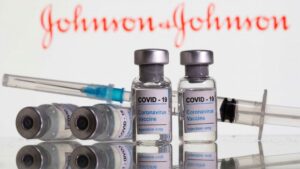The CDC and FDA have recommended that use of Johnson & Johnson’s Janssen (J&J/Janssen) COVID-19 Vaccine resume in the United States, effective April 23, 2021. However, women younger than 50 years old especially should be aware of the rare risk of blood clots with low platelets after vaccination, and that other COVID-19 vaccines are available where this risk has not been seen. 
Below are some common questions and answers as well as resources on where to find more information about the pause to the vaccine.
Please note: information about the vaccine is changing constantly. Please refer back to this page frequently for more information.
- It is a viral vector vaccine, like a flu shot.
-
- Viral vector vaccines use a modified version of a different virus (the vector) to deliver important instructions to our cells.
- The benefit of viral vector vaccines, like all vaccines, is those vaccinated gain protection without ever having to risk the serious consequences of getting sick with COVID-19.
- The vaccine does not include eggs, preservatives, or latex.
- It only requires one dose (shot).
- Possible side effects (similar to other vaccines):
-
- Pain
- Redness
- Swelling
- Tiredness
- Headache
- Muscle pain
- Chills
- Fever
- Nausea
- Typically go away after a day or two.
- The vaccine was 66.3% effective in clinical trials(efficacy) at preventing laboratory-confirmed COVID-19 illness.
- For adults 18 years old and up.
- The vaccine might provide protection against asymptomatic infection, which is when a person is infected by the virus that causes COVID-19 but does not get sick.
- The vaccine had high efficacy at preventing hospitalization and death in people who did get sick.
Since use of COVID-19 vaccines began in the United States, scientists and doctors have constantly and carefully reviewed all reports of vaccine side effects and adverse events. As of April 23, 2021, more than 8 million doses of the J&J/Janssen COVID-19 Vaccine had been given in the United States. As of April 23, 2021, experts reviewing safety reports for this vaccine found 15 reports of women who got the J&J/Janssen COVID-19 Vaccine and later developed thrombosis with thrombocytopenia syndrome (TTS). TTS is a serious condition that involves blood clots with low platelets.
These reports suggest an increased risk of TTS one to two weeks after vaccination with the J&J/Janssen COVID-19 Vaccine. As of April 23, 2021, the reports reviewed all occurred in women between 18 and 59 years old, with a median of 37 years. These reports represent a reporting rate of 7 such events per 1 million vaccinations among women 18 through 49 years old and a rate of 0.9 per 1 million vaccinations among women 50 years and older. For all women, this is a rare adverse event. For women 50 years and older and men of all ages, the adverse event is even more rare. Reports show that symptoms of this adverse event started between 6 and 15 days after vaccination.
The pause allowed CDC to communicate with healthcare providers and re-emphasize the importance of reporting severe events in people who have received this vaccine, as well as how to report such events.
The pause also gave experts time to carefully review all available data and conduct a risk-benefit analysis around the use of this vaccine.
There are a few reasons.
-
- This appears to be a very rare condition. The FDA and CDC will assess if there are safety measures providers can take that will allow us to safely continue to use this vaccine (similar to having everyone wait for 15 - 30 minutes after vaccination in case of anaphylaxis)
- Covid-19 is a very serious illness and vaccination is very important. The CDC and the FDA will weigh risks and decide the best way to proceed
COMMON side effects of the vaccine include:
In the arm where you got the shot:
Pain
Redness
Swelling
Throughout the rest of your body:
Tiredness
Headache
Muscle pain
Chills
Fever
Nausea
These side effects usually start within a day or two of getting the vaccine. They might feel like flu symptoms and might even affect your ability to do daily activities, but they should go away in a few days.
Side effects that should be monitored typically occur 6-13 days after vaccination and include: severe headache, abdominal pain, leg pain, or shortness of breath. If you experience these side effects you should contact your provider.
The risk of a blood clot occurring is less than 1 in 1,000,000 (1 million).
If you have concerns or are experiencing side effects, we recommend you contact your provider immediately.
Who SHOULD Get Vaccinated
- The J&J/Janssen vaccine is recommended for people aged 18 years and older.
- Learn more about how CDC is making COVID-19 vaccine recommendations and CDC’s vaccine rollout recommendations
Who Should NOT Get Vaccinated
- If you have had a severe allergic reaction (anaphylaxis) or an immediate allergic reaction—even if it was not severe—to any ingredientexternal icon in the J&J/Janssen COVID-19 vaccine (such as polysorbate), you should not get the J&J/Janssen COVID-19 vaccine.
- An allergic reaction is considered severe when a person needs to be treated with epinephrine or EpiPen© or if they must go to the hospital. Experts refer to severe allergic reactions as anaphylaxis. Learn about common side effects of COVID-19 vaccines and when to call a doctor.
- An immediate allergic reaction means a reaction within 4 hours of getting vaccinated, including symptoms such as hives, swelling, or wheezing (respiratory distress).
If you aren’t able to get the J&J/Janssen COVID-19 vaccine, you may still be able to get a different type of COVID-19 vaccine. Learn more information for people with allergies.
Resources:
Joint FDA/CDC Press Release
OHA Press Release
OHA FAQ Page
PBS News Hour: Ask the Experts